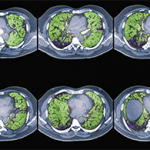Dr. Fischer recommended the pulmonologist’s “six-minute walk test” as a good way to assess functional status over time. It measures distance walked, heart rate, oxygen desaturation and how musculoskeletal disease affects performance, although it won’t distinguish ILD from pulmonary arterial hypertension (PAH) or other causes of hypoxia. He urged rheumatologists to keep their stethoscope handy and listen for crackles. But don’t assume that absence of crackles or of dyspnea means lack of ILD.
A Paucity of Data for Effective Treatment of Scleroderma
Although scleroderma patients with ILD typically face poor prospects, Francesco Boin, MD, director of the Scleroderma Center at the University of California, San Francisco, offered some additional perspectives on their management, treatment and future directions for research. “Scleroderma is a heterogeneous, multi-organ disease with overlapping features and burden of side effects,” he said. There are no proven, targeted therapies—no disease-modifying anti-rheumatic drugs (DMARDs)—for scleroderma, and a paucity of evidence-based data exist for what is effective.
As a result, management strategies come to the fore—starting with encouragement for smoking cessation by the patient. Promotion of vaccinations is also important, because any infection in the lungs can trigger new disease. Other supportive care strategies include management of esophageal dysfunction, acid reflux and risk for aspiration; pneumocystis pneumonia prophylaxis when indicated; oxygen therapy to help minimize hypoxemia; patient education and support including referrals to peer groups; and palliative care for breathlessness, cough and depression.
“Educate the patients that this is a chronic disease for life,” Dr. Boin said. “Tell them that a group of professionals will be caring for them, but they also need to learn more about their disease.”
The challenge for rheumatologists is knowing who to treat and when to treat and distinguishing early vs. end-stage disease, he said. Not all patients are affected to the same degree, so it’s important to determine severity of disease.
“With a lot of these patients, where the course of their disease is relatively benign, we wonder: do we really need to treat?” Patients with the best chance of responding to treatment may be those with higher risk of declining lung function, predicted poor outcome or more extensive disease at presentation.
Dr. Boin also emphasized looking for changes in function and using pulmonary function tests to assess disease progression over time.
The efficacy of corticosteroids for CTD‑ILDs remains controversial because no randomized controlled trials have yet proved their efficacy at moderate to high doses. In scleroderma patients, there is also the potential risk of renal crisis and other side effects from corticosteroid treatment.

